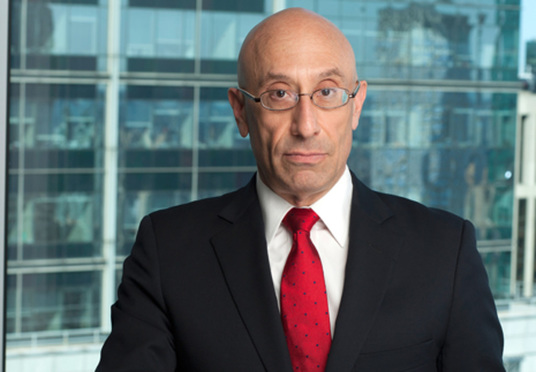Pryor Cashman Partner Fought the Regulators, and the Regulators ... Lost
Pinchus Raice could have had his career ruined after the FDIC leveled a $100,000 civil penalty against him. Instead, he faced regulators in their own administrative court and won, securing a settlement from the banking oversight corporation for $1.5 million.
March 12, 2018 at 07:24 PM
11 minute read
 Pinchus Raice.
Pinchus Raice. Administrative law proceedings, notoriously byzantine processes where defendants often feel that the deck is stacked against them, are challenging legal arenas for those under the watchful eye of regulators seeking enforcement decisions through their in-house litigation process.
For an attorney caught up in a regulatory action, the prospect of the administrative legal process has the potential to be a career-killer—even if you know you've done nothing wrong.
Pryor Cashman partner Pinchus Raice faced just such a prospect, when he faced potential professional ruin after the Federal Deposit Insurance Corp. brought breach of fiduciary duty, unsafe and sound practices, and other charges against him in the wake of the Park Avenue Bank collapse in 2010.
Raice's decision to fight the imposition of a $100,000 civil penalty for his alleged misdeeds meant going through the uncertainty of the administrative law process. In a rare victory, Raice not only saw himself entirely vindicated by the FDIC's board but, last fall, saw regulators agree to a $1.5 million settlement in his favor.
The win came after a years-long struggle with the FDIC's enforcement arm, born out of the collapse of a bank amid the ongoing fallout of the global financial crisis.
On March 12, 2010, the regulators with the FDIC, alongside their state counterparts at the New York Banking Department (which merged with the state's Insurance Department to become the Department of Financial Services in 2011) shut Park Avenue Bank down, with the FDIC taking over as receiver. According to the regulators, the bank was at risk from ineffective management, inadequate capital and a high volume of nonperforming loans.
The collapse would spawn a number of legal actions, most prominently the prosecution and conviction of the bank's former CEO and president, Charles Antonucci, for defrauding and embezzling federal Troubled Asset Relief Program funds.
Far less noticed, if at all, was the FDIC's subsequent action against Raice.
Another legal battled played out in the aftermath of the government seizure of Park Avenue Bank. Despite the dearth of headlines, the stakes were high for an attorney accused by regulators of pushing the bank's leadership to support an inappropriate financial decision for personal gain.
Raice, who co-chairs Pryor Cashman's financial institutions group, served as an outside counsel for Park Avenue ahead of its shuttering. The bank faced financial issues well before the global financial collapse. A legal battle erupted after the control of the bank switched hands in 2004. A substantial stake of nonvoting shares were being held by the Savings Deposit Insurance Fund of Turkey as part of a separate legal squabble.
The inability to control the bank's shares was impacting the bank's ability to raise capital, with the then-holder of the majority voting shares, David Lichtenstein, failing to have an option on the shares honored by the Turkish authorities. Investors were spooked. Lichtenstein, Antonucci and the bank's chairman David Glascoff took action, forming an outside entity called Deep Woods with the sole purpose of suing the Turkish officials into selling the shares.
Raice was called upon on numerous occasions to help the bank understand its relationship to this outside entity, which it obviously had a clear interest in. It was in this dynamic that regulators would argue both the bank and Raice committed misdeeds. At issue was a move by the bank to keep funding Deep Woods' legal battle after Lichtenstein, who owned 75 percent of the entity, was no longer able to.
It was Raice the bank turned to for advice on how best to proceed. While he provided input throughout this period, the bank's board was ultimately the ones who decided how to proceed, without Raice's involvement in any decision-making. The bank could effectively take over Lichtenstein's stake, a memo created by Raice and a Pryor Cashman colleague stated, as long as it handled things in the correct way, namely that its contributions could not be handled as loans, due to regulatory collateral requirements.
The bank made its first capital infusion to Deep Woods in June 2009. Some of the funds went to paying hundreds of thousands of dollars in legal expenses, some substantially overdue, to Pryor Cashman. Not long after this an examiner with the FDIC began digging into the transactions. By December, the FDIC had decided the move was a violation of FDIC rules. The bank would shudder within a year.
The FDIC's pursuit of wrongdoing didn't end with its probe into the decisions by the bank itself. In December 2014, the regulatory body found that Raice had helped the bank violate a number of regulations through unsafe and unsound practices that represented a breach of fiduciary duty. According to the FDIC, Raice's legal advice was meant to advance his self-interest in getting paid, sometimes at his urging, over that of the bank's interest in following the law. The FDIC assessed a $105,000 civil penalty against Raice.
The move was a rare attack on an attorney over the advice he'd given a client, according to Raice's attorney, fellow Pryor Cashman partner Jeffrey Alberts.
“The notion that they would say, 'Because you provided legal advice to a client and we don't agree with it, we're going to bring an enforcement action against you,' has this kind of effect on lawyers in the regulatory community,” he said. “Once they realize regulators are willing to take positions like that, and effectively try to take actions that could end the career of somebody who regularly appears before the regulator, it really changes the dynamic.”
Raice refused to settle the matter and the case went to trial before FDIC Administrative Law Judge C. Richard Miserendino.
Alberts, who himself is a former federal prosecutor in Manhattan, said he believed strongly that the FDIC simply didn't have a case, but was still choosing to charge ahead with their allegations.
“One thing that really struck me was the fact they were so willing to go through with the trial, even though the evidence seemed very clear … that Pinchus' position was correct—but even if it wasn't correct, it didn't even come close to suggesting he was advising a client to violate the law intentionally,” Alberts said.
Still, even if the evidence seemed so overwhelming in Raice's favor, Alberts acknowledged appearing before an ALJ can feel slanted in the government's favor.
“A lot of people in the industry told us, no matter how good your case is, because [of] this agency-judge dynamic, there's no way that you're going to win,” he said. “It can be unconscious on the part of judges. Because they're regularly presiding over cases where they see the same government attorneys, they can start to trust them in a way and not even notice it, and give them deference that isn't appropriate but becomes inevitable.”
The trial spanned over five days in the middle of January 2016. When he ruled in October, Miserendino showed he was willing to buck whatever real or imagined coziness existed between regulators and their in-house judges.
In a 62-page decision, Miserendino blew apart the government's theories about what had transpired in the Deep Woods matter. He dismantled each of the multiple regulatory infractions the FDIC said the bank made, finding that the government's central point—that the bank's cash infusions were actually loans—wasn't supported by anything in the record.
The best the government had to offer was language in Deep Woods' operating agreement that referenced the ability for managing members to call for loans to fund the entity's ongoing legal battle. That they could, the government contended, meant that the money the bank provided Deep Woods had to be considered loans. The problem, Miserendino said, was that there was zero evidence that any of the trapping around a loan or any line of credit—namely a requirement of repayment at a cost—were created.
The government's actions supported a “reasonable inference” that its decision-making process was “results oriented,” Miserendino stated.
Raice's actions and advice, then, failed to live up to the nefarious intents he was accused of by the government. First, Raice was not an institution-affiliated party, as the government asserted, Miserendino found. He was, rather, a contractor working outside the bank. As the administrative judge noted throughout his decision, Raice was often nowhere near the bank board when they were making decisions about what to do, gave legal advice to not provide loans to Deep Woods and which the bank followed, and pursued payment for the entirely justifiable reason of needing to be paid for work done.
Even with his victory before the ALJ, Raice's battle wasn't over. The ALJ's order amounts to only a recommendation that the FDIC's finding, including the $105,000 penalty, should be dismissed. It was up to the FDIC's board of directors to determine whether to adopt Miserendino's order.
“There have been other cases where the ALJ has found in favor, and that has then been reversed by the FDIC,” said Raice's attorney Alberts. “We were very concerned that the board might say, 'Thanks for this recommended decision, but we disagree with you.'”
The concern gave way to relief in March 2017, when the board sent a letter to Alberts announcing it was adopting Miserendino's decision and order to dismiss. As Alberts noted, this was the same board that originally authorized the action to go forward against Raice.
The following month, Raice filed an application for attorney fees and other expenses, which was opposed by the FDIC attorneys on the other side. Finding that it was in “the mutual interest … to enter into this agreement to avoid uncertainty and expense of litigation,” Raice and the FDIC settled.
“The final result was the FDIC, after seeking a $100,000 penalty, ended up paying over $1.5 million,” Alberts said.
William Isaac is a senior managing director with FTI Consulting Inc., and the global head of the firm's financial institutions practice. He's also a former chairman of the FDIC, having served at the corporation under both Presidents Jimmy Carter and Ronald Reagan. For him, the dynamics of the settlement negotiation showed that, “the FDIC, in the end, really didn't believe in its case.”
Isaac, who reviewed the case and provided an opinion in support of Raice ahead of trial, said the FDIC's enforcement arm's underlying problem was that it would have required an attorney to admit wrongdoing to settle the case, which would have “impacted him for the rest of his life.”
“I think that, faced with those circumstances, if you are that attorney, and you believe you behaved in an appropriate way, you're never going to settle. The stakes are too high here to resolve in a settlement; there's going to have to be a judgment,” he said.
Unlike other cases, where a civil penalty could be paid by someone facing scrutiny by the FDIC that “didn't matter in the end and be done with it,” Raice's case was seeking a punishment for an ethics violation. For an attorney under those circumstances, “everything's on the line,” Isaac said.
“Maybe the FDIC misjudged that. Maybe they thought, 'Well, of course the attorney will pay a $100,000 fine to be done with this.' But I think they misjudged what the stakes were on the other side,” he said.
Still, for Isaac, Raice's odyssey should be a cautionary tale for attorneys.
“One thing that lawyers need to learn is that there is a line—you cross it, you're in trouble,” he said.
Raice's attorney said he saw lessons for the FDIC as well. The problems in the FDIC's approach that led the ALJ to dismiss the charges, “should have been identified before they obtained authorization to proceed with the case,” Alberts said.
“Given the critical tone that was adopted both by the ALJ and ultimately by the board, I think it has to be interpreted in some way as saying, 'When you guys bring us cases and ask us to authorize them, you need to be more careful,'” he said.
A spokeswoman for the FDIC declined to comment.
This content has been archived. It is available through our partners, LexisNexis® and Bloomberg Law.
To view this content, please continue to their sites.
Not a Lexis Subscriber?
Subscribe Now
Not a Bloomberg Law Subscriber?
Subscribe Now
NOT FOR REPRINT
© 2025 ALM Global, LLC, All Rights Reserved. Request academic re-use from www.copyright.com. All other uses, submit a request to [email protected]. For more information visit Asset & Logo Licensing.
You Might Like
View All
Snapshot Judgement: The Case Against Illustrated Indictments

Read the Document: DOJ Releases Ex-Special Counsel's Report Explaining Trump Prosecutions
3 minute read
Ex-NYC Mayor de Blasio Must Pay $475K Fine for NYPD’s Presidential Campaign Security
3 minute read
Alston & Bird Adds M&A, Private Equity Team From McDermott in New York
4 minute readTrending Stories
- 1Meet Delaware's Incoming Lt. Gov.: 'It's a Natural Progression' From Litigation to Policy
- 2Class Action Settlements Totaled $40B+ Three Years in a Row: 'We’re in a New Era'
- 3Automaker Pleads Guilty and Agrees to $1.6 Billion in Payouts
- 4MLB's Texas Rangers Search For a New GC and a Broadcasting Deal
- 5Does the Treasury Hack Underscore a Big Problem for the Private Sector?
Who Got The Work
J. Brugh Lower of Gibbons has entered an appearance for industrial equipment supplier Devco Corporation in a pending trademark infringement lawsuit. The suit, accusing the defendant of selling knock-off Graco products, was filed Dec. 18 in New Jersey District Court by Rivkin Radler on behalf of Graco Inc. and Graco Minnesota. The case, assigned to U.S. District Judge Zahid N. Quraishi, is 3:24-cv-11294, Graco Inc. et al v. Devco Corporation.
Who Got The Work
Rebecca Maller-Stein and Kent A. Yalowitz of Arnold & Porter Kaye Scholer have entered their appearances for Hanaco Venture Capital and its executives, Lior Prosor and David Frankel, in a pending securities lawsuit. The action, filed on Dec. 24 in New York Southern District Court by Zell, Aron & Co. on behalf of Goldeneye Advisors, accuses the defendants of negligently and fraudulently managing the plaintiff's $1 million investment. The case, assigned to U.S. District Judge Vernon S. Broderick, is 1:24-cv-09918, Goldeneye Advisors, LLC v. Hanaco Venture Capital, Ltd. et al.
Who Got The Work
Attorneys from A&O Shearman has stepped in as defense counsel for Toronto-Dominion Bank and other defendants in a pending securities class action. The suit, filed Dec. 11 in New York Southern District Court by Bleichmar Fonti & Auld, accuses the defendants of concealing the bank's 'pervasive' deficiencies in regards to its compliance with the Bank Secrecy Act and the quality of its anti-money laundering controls. The case, assigned to U.S. District Judge Arun Subramanian, is 1:24-cv-09445, Gonzalez v. The Toronto-Dominion Bank et al.
Who Got The Work
Crown Castle International, a Pennsylvania company providing shared communications infrastructure, has turned to Luke D. Wolf of Gordon Rees Scully Mansukhani to fend off a pending breach-of-contract lawsuit. The court action, filed Nov. 25 in Michigan Eastern District Court by Hooper Hathaway PC on behalf of The Town Residences LLC, accuses Crown Castle of failing to transfer approximately $30,000 in utility payments from T-Mobile in breach of a roof-top lease and assignment agreement. The case, assigned to U.S. District Judge Susan K. Declercq, is 2:24-cv-13131, The Town Residences LLC v. T-Mobile US, Inc. et al.
Who Got The Work
Wilfred P. Coronato and Daniel M. Schwartz of McCarter & English have stepped in as defense counsel to Electrolux Home Products Inc. in a pending product liability lawsuit. The court action, filed Nov. 26 in New York Eastern District Court by Poulos Lopiccolo PC and Nagel Rice LLP on behalf of David Stern, alleges that the defendant's refrigerators’ drawers and shelving repeatedly break and fall apart within months after purchase. The case, assigned to U.S. District Judge Joan M. Azrack, is 2:24-cv-08204, Stern v. Electrolux Home Products, Inc.
Featured Firms
Law Offices of Gary Martin Hays & Associates, P.C.
(470) 294-1674
Law Offices of Mark E. Salomone
(857) 444-6468
Smith & Hassler
(713) 739-1250






